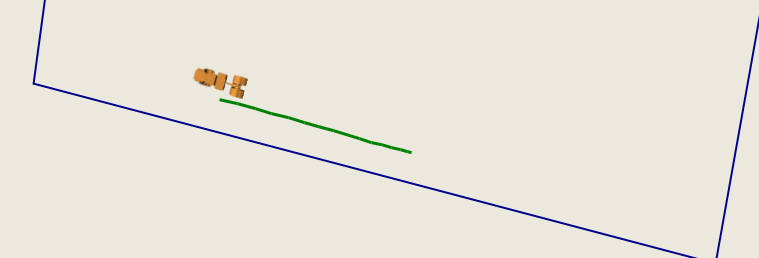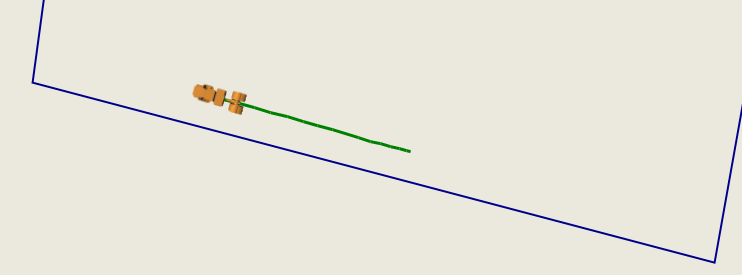当小车图片最为marker时,显示在gmap地图上会和轨迹有些偏移,marker中心没有在轨迹点上
如图所示:
纠正偏移的代码如下(有些是我自定义的,根据自己的需求进行改正
GMarkerGoogle marker;
Bitmap bitmap;
PointLatLng newendLatLng;
//获得旋转之后的marker
Bitmap bitmap = RotateImage(initialImage, pathAngle); //旋转图片的方法,pathAngle*(旋转角)在gps定位过程中了直接获取到
//将gmap经纬度转换成控件坐标 endLatLng是下一个点的经纬度坐标
gp = this.gMapControl.FromLatLngToLocal(new PointLatLng(endLatLng[0], endLatLng[1]));
//将控件坐标转化成gmap经纬度
newendLatLng = this.gMapControl.FromLocalToLatLng((int)gp.X, (int)(gp.Y + bitmap.Size.Height / 2));
marker = new GMarkerGoogle(new PointLatLng(newendLatLng.Lat,newendLatLng.Lng), bitmap);
traceMarkersOverlay.Markers.Add(marker);将图片进行旋转的方法代码如下
#region 旋转
private static Bitmap RotateImage(Image image,float angle)
{
if (image == null)
throw new ArgumentNullException("image");
const double pi2 = Math.PI / 2.0;
// Why can't C# allow these to be const, or at least readonly
// *sigh* I'm starting to talk like Christian Graus :omg:
double oldWidth = (double)image.Width;
double oldHeight = (double)image.Height;
// Convert degrees to radians
double theta = ((double)angle) * Math.PI / 180.0;
double locked_theta = theta;
// Ensure theta is now [0, 2pi)
while (locked_theta < 0.0)
locked_theta += 2 * Math.PI;
double newWidth, newHeight;
int nWidth, nHeight; // The newWidth/newHeight expressed as ints
#region Explaination of the calculations
/*
* The trig involved in calculating the new width and height
* is fairly simple; the hard part was remembering that when
* PI/2 <= theta <= PI and 3PI/2 <= theta < 2PI the width and
* height are switched.
*
* When you rotate a rectangle, r, the bounding box surrounding r
* contains for right-triangles of empty space. Each of the
* triangles hypotenuse's are a known length, either the width or
* the height of r. Because we know the length of the hypotenuse
* and we have a known angle of rotation, we can use the trig
* function identities to find the length of the other two sides.
*
* sine = opposite/hypotenuse
* cosine = adjacent/hypotenuse
*
* solving for the unknown we get
*
* opposite = sine * hypotenuse
* adjacent = cosine * hypotenuse
*
* Another interesting point about these triangles is that there
* are only two different triangles. The proof for which is easy
* to see, but its been too long since I've written a proof that
* I can't explain it well enough to want to publish it.
*
* Just trust me when I say the triangles formed by the lengths
* width are always the same (for a given theta) and the same
* goes for the height of r.
*
* Rather than associate the opposite/adjacent sides with the
* width and height of the original bitmap, I'll associate them
* based on their position.
*
* adjacent/oppositeTop will refer to the triangles making up the
* upper right and lower left corners
*
* adjacent/oppositeBottom will refer to the triangles making up
* the upper left and lower right corners
*
* The names are based on the right side corners, because thats
* where I did my work on paper (the right side).
*
* Now if you draw this out, you will see that the width of the
* bounding box is calculated by adding together adjacentTop and
* oppositeBottom while the height is calculate by adding
* together adjacentBottom and oppositeTop.
*/
#endregion
double adjacentTop, oppositeTop;
double adjacentBottom, oppositeBottom;
// We need to calculate the sides of the triangles based
// on how much rotation is being done to the bitmap.
// Refer to the first paragraph in the explaination above for
// reasons why.
if ((locked_theta >= 0.0 && locked_theta < pi2) ||
(locked_theta >= Math.PI && locked_theta < (Math.PI + pi2)))
{
adjacentTop = Math.Abs(Math.Cos(locked_theta)) * oldWidth;
oppositeTop = Math.Abs(Math.Sin(locked_theta)) * oldWidth;
adjacentBottom = Math.Abs(Math.Cos(locked_theta)) * oldHeight;
oppositeBottom = Math.Abs(Math.Sin(locked_theta)) * oldHeight;
}
else
{
adjacentTop = Math.Abs(Math.Sin(locked_theta)) * oldHeight;
oppositeTop = Math.Abs(Math.Cos(locked_theta)) * oldHeight;
adjacentBottom = Math.Abs(Math.Sin(locked_theta)) * oldWidth;
oppositeBottom = Math.Abs(Math.Cos(locked_theta)) * oldWidth;
}
newWidth = adjacentTop + oppositeBottom;
newHeight = adjacentBottom + oppositeTop;
nWidth = (int)Math.Ceiling(newWidth);
nHeight = (int)Math.Ceiling(newHeight);
Bitmap rotatedBmp = new Bitmap(nWidth, nHeight);
using (Graphics g = Graphics.FromImage(rotatedBmp))
{
// This array will be used to pass in the three points that
// make up the rotated image
Point[] points;
/*
* The values of opposite/adjacentTop/Bottom are referring to
* fixed locations instead of in relation to the
* rotating image so I need to change which values are used
* based on the how much the image is rotating.
*
* For each point, one of the coordinates will always be 0,
* nWidth, or nHeight. This because the Bitmap we are drawing on
* is the bounding box for the rotated bitmap. If both of the
* corrdinates for any of the given points wasn't in the set above
* then the bitmap we are drawing on WOULDN'T be the bounding box
* as required.
*/
if (locked_theta >= 0.0 && locked_theta < pi2)
{
points = new Point[] {
new Point( (int) oppositeBottom, 0 ),
new Point( nWidth, (int) oppositeTop ),
new Point( 0, (int) adjacentBottom )
};
}
else if (locked_theta >= pi2 && locked_theta < Math.PI)
{
points = new Point[] {
new Point( nWidth, (int) oppositeTop ),
new Point( (int) adjacentTop, nHeight ),
new Point( (int) oppositeBottom, 0 )
};
}
else if (locked_theta >= Math.PI && locked_theta < (Math.PI + pi2))
{
points = new Point[] {
new Point( (int) adjacentTop, nHeight ),
new Point( 0, (int) adjacentBottom ),
new Point( nWidth, (int) oppositeTop )
};
}
else
{
points = new Point[] {
new Point( 0, (int) adjacentBottom ),
new Point( (int) oppositeBottom, 0 ),
new Point( (int) adjacentTop, nHeight )
};
}
g.DrawImage(image, points);
}
return rotatedBmp;
}
#endregion
实现之后的效果如下图所示
























 988
988

 被折叠的 条评论
为什么被折叠?
被折叠的 条评论
为什么被折叠?








